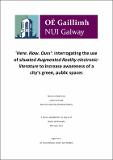| dc.contributor.advisor | Holohan, Conn | |
| dc.contributor.author | Gwalchmai, Benjamin (John Nicholas) | |
| dc.date.accessioned | 2022-03-22T12:31:01Z | |
| dc.date.available | 2022-03-22T12:31:01Z | |
| dc.date.issued | 2022-02-02 | |
| dc.identifier.uri | http://hdl.handle.net/10379/17048 | |
| dc.description.abstract | The aim of this practice-based research is to investigate the use of situated Augmented Reality electronic literature (eLit) as a new way of increasing awareness of a city’s green spaces in its citizens. Its hypothesis is that both its situated nature and the embodied nature of its Augmented Reality (AR) can make it effective in increasing awareness of those green spaces – as well as increasing agency & civic will. The use of new Augmented Reality (AR) technology combined with situated eLit brings an innovative approach to raising public awareness while also highlighting ideas about urban psychogeography, play, public and private ownership of urban environments, and surveillance capitalism. This hypothesis can also be formulated as the question ‘Can eLit and AR increase awareness of the reader’s shared public, green spaces and increase their civic will that, in turn, they act on?’
To answer that question, this research includes both a written theoretical component and the development, testing, and meta-reflection of a smartphone-based AR app, Here. Now. Ours. The app was designed to increase awareness of urban green, public spaces and was put to the test in a Case Study with participants.
As an interdisciplinary and intermedial piece of research that saw participants becoming an Augmented Wandersmänner across a city, the methodology had to be generative, phenomenological, ambient, epistemic, ethnographic, examining digital power structures, and critiqued sharply – a Critical Reflection chapter, after the Case Study Results, critiques the work and details the difficulties it faced. Participants in the Case Study were debriefed and interviewed with both quantitative and qualitative questions which gave the research its results.
The results of the case study can be put simply as: in the majority, participants stated they were more aware of their city’s green spaces through the use of situated AR eLit. The significance of this investigation is demonstrating that situated eLit has a place beyond the screen and in enabling people to understand the street, better, while also demonstrating that tools can be created to actualise agency. | en_IE |
| dc.publisher | NUI Galway | |
| dc.rights | Attribution-NonCommercial-NoDerivs 3.0 Ireland | |
| dc.rights | CC BY-NC-ND 3.0 IE | |
| dc.rights.uri | https://creativecommons.org/licenses/by-nc-nd/3.0/ie/ | |
| dc.rights.uri | https://creativecommons.org/licenses/by-nc-nd/3.0/ie/ | |
| dc.subject | Augmented Reality | en_IE |
| dc.subject | City Planning | en_IE |
| dc.subject | Big Data | en_IE |
| dc.subject | Slow Data | en_IE |
| dc.subject | Phenomenology | en_IE |
| dc.subject | Haptic Phenomenology | en_IE |
| dc.subject | situated eLiterature | en_IE |
| dc.subject | situated literature | en_IE |
| dc.subject | literature | en_IE |
| dc.subject | Wandersmänner | en_IE |
| dc.subject | Augmented Wandersmänner | en_IE |
| dc.subject | agency | en_IE |
| dc.subject | civic will | en_IE |
| dc.subject | Arts, Social Sciences & Celtic Studies | en_IE |
| dc.subject | English and Creative Arts | en_IE |
| dc.subject | Huston School of Film & Digital Media | en_IE |
| dc.title | ‘Here. Now. Ours’: interrogating the use of situated Augmented Reality electronic-literature to increase awareness of a city’s green, public spaces | en_IE |
| dc.type | Thesis | en |
| dc.contributor.funder | National University of Ireland, Galway | en_IE |
| dc.local.note | This PhD developed an playful, literate Augmented Reality smartphone app that creatively led the player to green spaces in Galway and showed them the number of planning applications in that area. This proved to encourage awareness of the, previously opaque, planning process in the participants and engage them in the civic processes of their city more. | en_IE |
| dc.local.final | Yes | en_IE |
| nui.item.downloads | 223 | |


